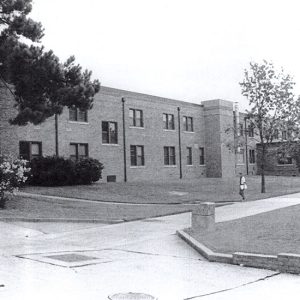calsfoundation@cals.org
Cross and Nelson Hall Historic District
The Cross and Nelson Hall Historic District consists of two former dormitories located at 100 East University on the campus of Southern Arkansas University (SAU) in Magnolia (Columbia County). These were built in 1936 with assistance from the Public Works Administration (PWA), a Depression-era federal relief agency. The district was listed on the National Register of Historic Places on January 20, 2010.
The Third District Agricultural School, which would evolve into Southern Arkansas University, was one of four such schools created through Act 100 of 1909 of the Arkansas General Assembly, with its first classes meeting in 1911. At the time, the school offered a four-year high school diploma program. By the mid-1920s, the school had received junior college status as the State Agricultural and Mechanical College, Third District, though it was colloquially known as Magnolia A&M.
The Great Depression did not greatly affect the college, which deliberately kept tuition down in order to attract students, and by the mid-1930s school leaders recognized the need for new dormitories for both male and female students. They turned to the Public Works Administration, one of President Franklin D. Roosevelt’s New Deal agencies, for funding. On September 25, 1935, the PWA awarded Magnolia A&M a $63,000 grant and $77,000 loan to finance construction of two dormitories and to reconstruct the campus’s library. Construction on the new dormitories proceeded rapidly, with work beginning on March 13, 1936, and concluding on November 21, 1936.
The boys’ dormitory, Cross Hall, is a two-story, L-shaped building designed in the Plain Traditional style of architecture, with minimal traces of the Colonial Revival and Collegiate Revival styles. It is named for William R. Cross, an insurance agent and civic booster who led the effort to bring the Third District Agricultural School to Magnolia in 1910, beating out several other towns in the region. Cross Hall now houses classrooms and offices for professors.
Nelson Hall, originally built as the girls’ dormitory, shares the same design ethic as Cross Hall. Named for Mary H. Nelson, the first dean of women at Magnolia A&M, it houses administrative offices in the twenty-first century.
The Cross and Nelson Hall Historic District also has a bell tower/water tower that was constructed in 1976, the year Magnolia A&M received university status from the state Board of Education. The 187-foot Cor-Ten steel structure holds fourteen cast-bronze bells and 50,000 gallons of water, winning “Steel Tank of the Year” honors from the Steel Plate Fabricators Association in the year it was built. The tower is considered non-contributing to the district’s historic significance.
For additional information:
Chesnutt, Edgar B. “In Arkansas Today, It’s the ‘Big’ Red Schoolhouse.” Arkansas Gazette Magazine, September 13, 1936, pp. 1, 3.
Federal Works Agency Public Works Administration. “List of All Allotted Non-Federal Projects, All Programs, By State and Docket, as of May 30, 1942.” On file at Arkansas Historic Preservation Program, Little Rock, Arkansas.
Hope, Holly. “An Ambition to be Preferred: New Deal Recovery Efforts and Architecture in Arkansas, 1933–1943.” Little Rock: Arkansas Historic Preservation Program, 2006. Online at http://www.arkansaspreservation.com/News-and-Events/publications (accessed May 25, 2020).
Swaim, Kathleen. “Cross and Nelson Hall Historic District.” National Register of Historic Places registration form. On file at Arkansas Historic Preservation Program, Little Rock, Arkansas. Online at https://www.arkansasheritage.com/docs/default-source/national-registry/co0428-pdf.pdf?sfvrsn=67a6e5aa_0 (accessed May 25, 2022).
Willis, James F. Southern Arkansas University: The Mulerider School’s Centennial History, 1909–2009. Bloomington, IN: Xlibris Publishing, 2009.
Mark K. Christ
Central Arkansas Library System
 Early Twentieth Century, 1901 through 1940
Early Twentieth Century, 1901 through 1940 Historic Preservation
Historic Preservation Cross and Nelson Hall Historic District
Cross and Nelson Hall Historic District 




Comments
No comments on this entry yet.